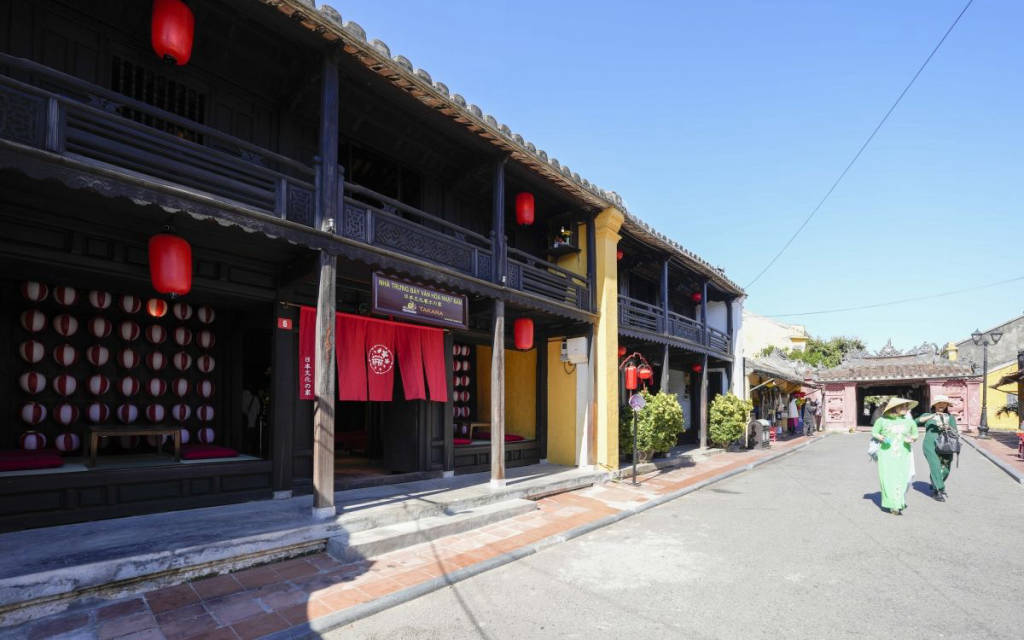The Japanese Cultural Gallery, located on Nguyen Thi Minh Khai Street, Cam Pho Ward, Hoi An City, is a unique destination that recreates the cultural exchange between Japan and Vietnam since the 17th century. With traditional architecture and many valuable artifacts, this place introduces the beauty of Japanese culture and art and the long-standing connection with Hoi An. This is an ideal stopover for tourists who love culture.
Japanese Culture Gallery – A Unique Cultural Destination in Hoi An
The Japanese Culture Gallery is one of the unique destinations in Hoi An, preserving and showcasing the deep cultural values shared between Vietnam and Japan. If Hoi An symbolizes cultural exchange, this place highlights a special bond that has lasted for centuries.
1. Location and Special Significance
The Japanese Culture Gallery is located in the heart of Hoi An Ancient Town, near Chùa Cầu (Japanese Covered Bridge) – a symbol of Vietnamese-Japanese cultural exchange. This establishment is not just an ordinary museum but a cultural bridge, helping visitors understand the strong relationship between the two nations. Hoi An was a bustling international trading port in the 16th-17th centuries, where Japanese merchants came to trade and settle, leaving long-lasting impressions on architecture, lifestyle, and customs. The gallery is a modern symbol of that historical heritage.
2. History and Architecture
The Japanese Culture Gallery was built to honor and preserve Japanese cultural values in Hoi An. The building features classical Japanese architectural styles combined with local elements of Hoi An. From the main gate to the interior, visitors will notice the elegance in every detail such as the curved tiled roof, wooden sliding doors, and open spaces that welcome natural light.
The gallery is divided into various spaces, each telling a unique cultural, historical, or artistic story. Visiting here, guests will feel like they are stepping into a miniature Japan within Hoi An.
3. Highlighted Cultural Features
Here, visitors can admire and learn about various interesting aspects of Japanese culture, from history and art to daily life.
3.1. Geisha Tradition and Tea Ceremony Art
In the tea ceremony and Geisha exhibition area, visitors will experience the spirit of “Wabi-Sabi” – the beauty of simplicity and subtlety. Traditional tea sets and images of Geishas in colorful kimonos recreate a part of ancient Japanese culture. Guides often share how tea ceremonies are not just a form of entertainment but an art of living, honoring elegance and peace.
3.2. Handicrafts and Ceramics
Another section of the gallery focuses on traditional crafts such as Kutani ceramics, paper lanterns, and Kokeshi dolls. These products are crafted by skilled Japanese artisans and are highly symbolic in Japanese culture. Especially, the simple yet story-telling paper lanterns depict spiritual life and customs.
3.3. Traditional Attire and Origami Art
Visitors will have the chance to see beautiful kimonos, from traditional to modern designs. Moreover, in this area, guests can participate in Origami workshops, learning to create delicate paper cranes and lotus flowers, providing a fun and unforgettable experience.
3.4. Japanese Cuisine Through an Artistic Lens
An unmissable part is the displays related to Japanese cuisine, from sushi and sashimi to wagashi sweets. Through these, visitors will understand the philosophy of Japanese cuisine, focusing on balance, subtlety, and aesthetics.
4. Experience Activities and Special Events
The Japanese Culture Gallery is not just a place to look and listen but also to experience firsthand.
Trying on Kimonos: Visitors can wear beautiful kimonos and take souvenir photos in the Japanese-themed space.
Practicing Origami: Small workshops will guide visitors in creating beautiful Origami works.
Making Sushi: On special days, visitors can join basic sushi-making classes, learning to prepare and present the dish.
Additionally, the gallery often hosts art performances such as fan dances, Kendo sword dances, or traditional Japanese musical instrument performances, creating a lively and captivating atmosphere.
5. Cultural Connection Significance
The Japanese Culture Gallery is not just a place to store artifacts but also a symbol of the long-standing friendship between Vietnam and Japan. Through each story and display corner, visitors will feel the connection between the two nations over time. This is a place that honors cultural exchange, helping people understand the origins and value of international cooperation.
6. Conclusion
Dear visitors, the journey to explore the Japanese Culture Gallery has taken us back in time, feeling the beauty of Japanese history and art in an ancient place like Hoi An. Tatinta believes that everyone will take home not just beautiful photos but also deep memories and a better understanding of the culture of a wonderful country. Wishing you a joyful and meaningful visit.
 Register
RegisterSign in Travel Agent
Sign in Supplier
Sign in Affiliate
Sign in Guru



 đường Nguyễn Thị Minh Khai, P. Cẩm Phô, Tp. Hội An, T. Quảng Nam, Việt Nam
đường Nguyễn Thị Minh Khai, P. Cẩm Phô, Tp. Hội An, T. Quảng Nam, Việt Nam